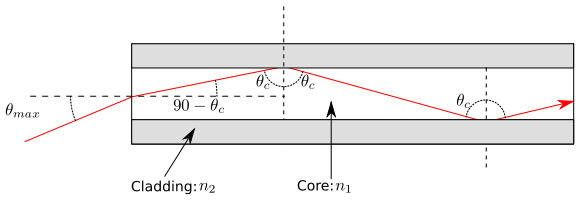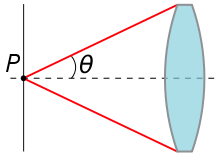- Numerical aperture
-
In optics, the numerical aperture (NA) of an optical system is a dimensionless number that characterizes the range of angles over which the system can accept or emit light. By incorporating index of refraction in its definition, NA has the property that it is constant for a beam as it goes from one material to another provided there is no optical power at the interface. The exact definition of the term varies slightly between different areas of optics.
Contents
General optics
In most areas of optics, and especially in microscopy, the numerical aperture of an optical system such as an objective lens is defined by
where n is the index of refraction of the medium in which the lens is working (1.0 for air, 1.33 for pure water, and up to 1.56 for oils; see also list of refractive indices), and θ is the half-angle of the maximum cone of light that can enter or exit the lens. In general, this is the angle of the real marginal ray in the system. Because the index of refraction is included, the NA of a pencil of rays is an invariant as a pencil of rays passes from one material to another through a flat surface. This is easily shown by rearranging Snell's law to find that nsinθ is constant across an interface.
In air, the angular aperture of the lens is approximately twice this value (within the paraxial approximation). The NA is generally measured with respect to a particular object or image point and will vary as that point is moved. In microscopy, NA generally refers to object-space NA unless otherwise noted.
In microscopy, NA is important because it indicates the resolving power of a lens. The size of the finest detail that can be resolved is proportional to λ/2NA, where λ is the wavelength of the light. A lens with a larger numerical aperture will be able to visualize finer details than a lens with a smaller numerical aperture. Assuming quality (diffraction limited) optics, lenses with larger numerical apertures collect more light and will generally provide a brighter image, but will provide shallower depth of field.
Numerical aperture is used to define the "pit size" in optical disc formats.[1]
Numerical aperture versus f-number
 Numerical aperture of a thin lens.
Numerical aperture of a thin lens.
Numerical aperture is not typically used in photography. Instead, the angular aperture of a lens (or an imaging mirror) is expressed by the f-number, written f/# or N, which is defined as the ratio of the focal length to the diameter of the entrance pupil:
This ratio is related to the image-space numerical aperture when the lens is focused at infinity.[2] Based on the diagram at the right, the image-space numerical aperture of the lens is:

- thus
 , assuming normal use in air (n = 1).
, assuming normal use in air (n = 1).
The approximation holds when the numerical aperture is small, and it is nearly exact even at large numerical apertures for well-corrected camera lenses. For numerical apertures less than about 0.5 (f-numbers greater than about 1) the divergence between the approximation and the full expression is less than 10%. Beyond this, the approximation breaks down. As Rudolf Kingslake explains, "It is a common error to suppose that the ratio [D / 2f ] is actually equal to tanθ, and not sinθ ... The tangent would, of course, be correct if the principal planes were really plane. However, the complete theory of the Abbe sine condition shows that if a lens is corrected for coma and spherical aberration, as all good photographic objectives must be, the second principal plane becomes a portion of a sphere of radius f centered about the focal point, ..."[3] In this sense, the traditional thin-lens definition and illustration of f-number is misleading, and defining it in terms of numerical aperture may be more meaningful.
"Working" or "effective" f-number
The f-number describes the light-gathering ability of the lens in the case where the marginal rays on the object side are parallel to the axis of the lens. This case is commonly encountered in photography, where objects being photographed are often far from the camera. When the object is not distant from the lens, however, the image is no longer formed in the lens's focal plane, and the f-number no longer accurately describes the light-gathering ability of the lens or the image-side numerical aperture. In this case, the numerical aperture is related to what is sometimes called the "working f-number" or "effective f-number." The working f-number is defined by modifying the relation above, taking into account the magnification from object to image:
where Nw is the working f-number, m is the lens's magnification for an object a particular distance away, and the NA is defined in terms of the angle of the marginal ray as before.[2][4] The magnification here is typically negative; in photography, the factor is sometimes written as 1 + m, where m represents the absolute value of the magnification; in either case, the correction factor is 1 or greater.
The two equalities in the equation above are each taken by various authors as the definition of working f-number, as the cited sources illustrate. They are not necessarily both exact, but are often treated as if they are. The actual situation is more complicated — as Allen R. Greenleaf explains, "Illuminance varies inversely as the square of the distance between the exit pupil of the lens and the position of the plate or film. Because the position of the exit pupil usually is unknown to the user of a lens, the rear conjugate focal distance is used instead; the resultant theoretical error so introduced is insignificant with most types of photographic lenses."[5]
Conversely, the object-side numerical aperture is related to the f-number by way of the magnification (tending to zero for a distant object):
Laser physics
In laser physics, the numerical aperture is defined slightly differently. Laser beams spread out as they propagate, but slowly. Far away from the narrowest part of the beam, the spread is roughly linear with distance—the laser beam forms a cone of light in the "far field". The relation used to define the NA of the laser beam is the same as that used for an optical system,
but θ is defined differently. Laser beams typically do not have sharp edges like the cone of light that passes through the aperture of a lens does. Instead, the irradiance falls off gradually away from the center of the beam. It is very common for the beam to have a Gaussian profile. Laser physicists typically choose to make θ the divergence of the beam: the far-field angle between the propagation direction and the distance from the beam axis for which the irradiance drops to 1/e2 times the wavefront total irradiance. The NA of a Gaussian laser beam is then related to its minimum spot size by
where λ0 is the vacuum wavelength of the light, and 2w0 is the diameter of the beam at its narrowest spot, measured between the 1/e2 irradiance points ("Full width at e−2 maximum of the intensity"). Note that this means that a laser beam that is focused to a small spot will spread out quickly as it moves away from the focus, while a large-diameter laser beam can stay roughly the same size over a very long distance.
Fiber optics
A multi-mode optical fiber will only propagate light that enters the fiber within a certain cone, known as the acceptance cone of the fiber. The half-angle of this cone is called the acceptance angle, θmax. For step-index multimode fiber, the acceptance angle is determined only by the indices of refraction:
where n1 is the refractive index of the fiber core, and n2 is the refractive index of the cladding.

When a light ray is incident from a medium of refractive index n to the core of index n1 at the maximum acceptance angle, Snell's law at the medium–core interface gives
From the geometry of the above figure we have:
where
 is the critical angle for total internal reflection.
is the critical angle for total internal reflection.Substituting cos θc for sin θr in Snell's law we get:
By squaring both sides
Solving, we find the formula stated above:
This has the same form as the numerical aperture in other optical systems, so it has become common to define the NA of any type of fiber to be
where n1 is the refractive index along the central axis of the fiber. Note that when this definition is used, the connection between the NA and the acceptance angle of the fiber becomes only an approximation. In particular, manufacturers often quote "NA" for single-mode fiber based on this formula, even though the acceptance angle for single-mode fiber is quite different and cannot be determined from the indices of refraction alone.
The number of bound modes, the mode volume, is related to the normalized frequency and thus to the NA.
In multimode fibers, the term equilibrium numerical aperture is sometimes used. This refers to the numerical aperture with respect to the extreme exit angle of a ray emerging from a fiber in which equilibrium mode distribution has been established.
See also
References
- ^ "High-def Disc Update: Where things stand with HD DVD and Blu-ray" by Steve Kindig, Crutchfield Advisor. Accessed 2008-01-18.
- ^ a b Greivenkamp, John E. (2004). Field Guide to Geometrical Optics. SPIE Field Guides vol. FG01. SPIE. ISBN 0-8194-5294-7. http://books.google.com/?id=1YfZNWZAwCAC&pg=PA29&dq=inauthor:greivenkamp+numerical-aperture. p. 29.
- ^ Rudolf Kingslake (1951). : The Practical Guide to Optics for Photographers. Case-Hoyt Corp. for Garden City Books. pp. 97–98. http://books.google.com/?id=9u2WGQAACAAJ&dq=intitle:photography+inauthor:kingslake.
- ^ Angelo V Arecchi, Tahar Messadi, and R. John Koshel (2007). Field Guide to Illumination. SPIE. p. 48. ISBN 9780819467683. http://books.google.com/?id=Ax0RqdqeDG0C&pg=PP14&dq=working-f-number+aperture.
- ^ Allen R. Greenleaf (1950). Photographic Optics. The Macmillan Company. p. 24. http://books.google.com/?id=L4dtAAAAIAAJ&q=intitle:optics+inauthor:greenleaf+%22position+of+the+exit+pupil%22&dq=intitle:optics+inauthor:greenleaf+%22position+of+the+exit+pupil%22.
 This article incorporates public domain material from the General Services Administration document "Federal Standard 1037C" (in support of MIL-STD-188).
This article incorporates public domain material from the General Services Administration document "Federal Standard 1037C" (in support of MIL-STD-188).
External links
- "Microscope Objectives: Numerical Aperture and Resolution" by Mortimer Abramowitz and Michael W. Davidson, Molecular Expressions: Optical Microscopy Primer (website), Florida State University, April 22, 2004.
- "Basic Concepts and Formulas in Microscopy: Numerical Aperture" by Michael W. Davidson, Nikon MicroscopyU (website).
- "Numerical aperture", Encyclopedia of Laser Physics and Technology (website).
- "Numerical Aperture and Resolution", UCLA Brain Research Institute Microscopy Core Facilities (website), 2007.
Categories:- Optics
- Fiber optics
- Microscopy
Wikimedia Foundation. 2010.














